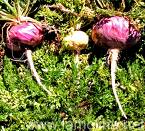| Kingdom | Plantae |
| Unranked | Angiosperms |
| Unranked | Eudicots |
| Order | Brassicales |
| Family | Brassicaceae |
| Genus | Lepidium |
| Species | L. meyenii |
| Binomial name | Lepidium meyenii |
Other Common Names:
The other common names for maca are maino, pepper grass, pepper weed, ayak chichira, and ayak willku.
History
The MACA plants leaves and roots are both edible.Lepidium Meyenii belongs to the botanical family of Brassicaceae, which has over 3000 species throughout the world. Lepidium meyenii is related with mustard, radishes and turnips. Among the common names of Lepidium meyenii we can find "Peruvian ginseng", "maka", "maino", etc. One curious thing about Lepidium meyenii is that this vegetable has several scientific names, but the most widely used is Lepidium meyenii.

Description
It is an annual herbaceous plant. The root is tuberose -i.e., swollen- a word that comes from tuber in Latin. Its stems are underground and measure 10 to 14 cm in length and 3 to 5 cm in diameter in the widest part; they measure 15 cm in circumference. The plant presents a big quantity of white rootlets reaching up to 15 cm in length, extended in all directions. With hard consistency, it is found in two types of colours: yellow and purple.


Range
Maca is a plant grown at high altitudes in the Andes. The maca is one of the Andean crops which occupy a very restricted area. It is found only on the central sierra of Peru in the departments of Junín and Pasco, in the puna agro-ecological zone above 4 000 m where low temperatures and strong winds limit other crops.
Habitat
MACA grows in altitudes from 12,500 to14, 500 feet, and can be found flourishing in cold climates, where the soil quality is quite poor. It is generally seen in barren steppes, tundra and alpine plains, usually in limestone and clay soils where low temperatures and strong winds limit other crops.
Cultivation
The mace is sown at the beginning of the rainy period (September-November) as the sole crop or combined with strips of bitter potato. It can be sown on freshly ploughed pasture land that has lain fallow, or on ground under an annual rotation with another crop such as the bitter potato. Generally speaking, soil preparation is deficient and broadcast sowing is carried out without any fertilization or, at best, only a manure dressing. The seeds are buried using branches or are let's to be trod on by sheep. Tillage is not usually carried out, except to make sure that the small plants are not trampled by animals. The mace is believed to deplete the soil; this probably occurs when the nutrients removed are not sufficiently replenished. Harvesting begins in May or June. The fresh hypocotyls are exposed to the sun's rays for about four to six days until they are dry. They are then stored in a cool, dark place until they are eaten. The yield is very variable: in fields where little care has been devoted to managing the crop, about 2 to 3 tonnes per hectare are obtained while, with appropriate row cultivation practices, fertilization and the prevention of pest attacks, it is possible to produce up to 15 to 16 tonnes per hectare.
Plants which produce the hypocotyl in the first year do not produce seed. The following practices are carried out to obtain seed: after selecting the biggest, soundly formed and suitably ripened hypocotyls, between 30 and 50 are placed in a hole which is 50 to 60 cm deep and of the same radius and which is covered with damp earth. The plantlets take 25 to 30 days to grow. To transfer them, a seed bed is prepared with soft earth and fertilized with farmyard manure. Care must be taken to ensure that there is adequate humidity for the vigorous development of the plants, which will produce seeds within six to seven months after transplanting.
Parts Used

The tuber, root and the leaves are the most commonly used parts of maca for its commercial and medicinal purposes.
Flowering Season
The flowers are hermaphrodite which are continually in bloom for three months.
Pests and Diseases
Attacks by pests, such as weevils, may cause the loss of an entire crop; studies on the integrated control of these pests, through cultivation practices, biological control using the fungus Beauveriabrogniartii, post harvest management and the use of resistant varieties would need to be carried out.
Medicinal Applications


• Lepidium Meyenii is used in weight loss products, because some manufacturers suggest that it has some ability to help stimulate the hypothalamus and pituitary gland to better balance the entire endocrine system, which includes thyroid function.
• Lepidium meyenii relieves the 34 menopause symptoms because of its natural ability to help the body balance hormonal levels.
• Instead of just temporary energy lift like caffeine energizers, this herb optimizes body functioning for long-term energy..
• There are reports that this plant can cure many problems of infertility.
• It s also used in the treatment of cancer.
• By normalizing testosterone levels (main sex hormone), Lepidium meyenii stimulate the body for an enhanced and pleasuring sexual life.
• Lepidium meyenii has been used for centuries as a potent fertilizer by native Peruvians.
Commercial Applications


• Maca can be liquefied to prepare juices, cocktails, porridges and jams.
• The root is previously dried and then decocted in order to be used.
• The leaves are consumed as a complement for salads.
• The Lepidium meyenii leaves serve as food for livestock (especially for guinea pigs), and to prepare salads.
• The young leaves are eaten raw or cooked.

According to the chronicles, Lepidium meyenii was considered sacred food used successfully as an aphrodisiac, and to increase energy levels. It was destined specially for the Incan royalty. But also, the Incan warriors had Lepidium meyenii because it offered to vitality and physical force to the battle. Also, some chronicles state that Incan warriors consumed Lepidium meyenii before entering into battle because this would make them extremely strong.
But after conquering a city, the Incan soldiers were forbidden from using Lepidium meyenii in order to protect the conquered women from the warrior's powerful sexual impulses. After obtaining great results, Lepidium meyenii reached so much popularity that it was used as currency. Colonial records dating back 200 years indicate that payments of roughly 9 tons of Lepidium meyenii were demanded from one Andean area alone for fertility purposes.